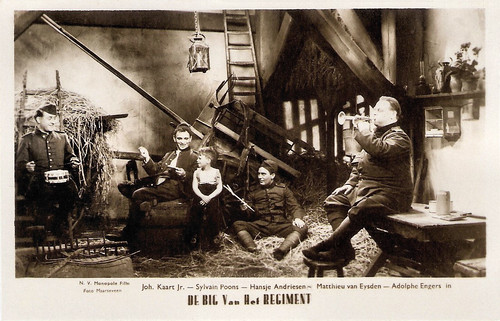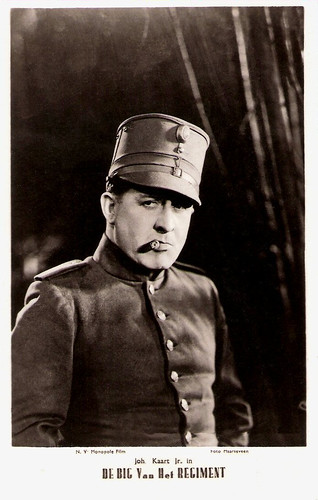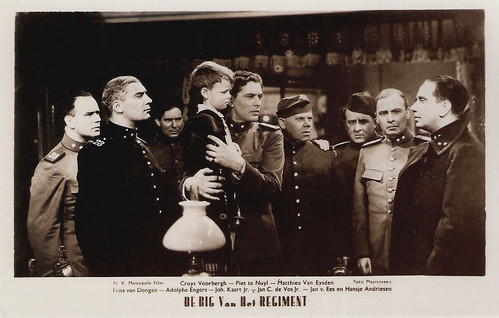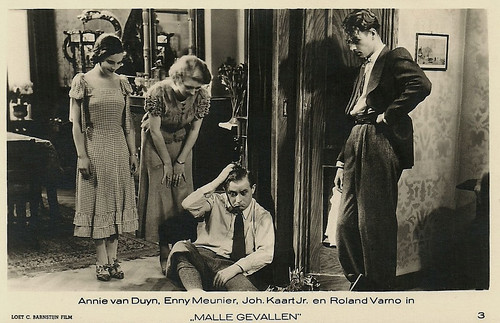For decades, Johan Kaart junior (1897-1976) was a huge star in the Dutch entertainment world. Between 1934 and 1937, he starred in seven films and after the war he played in several more films. He also often worked for radio and television, but his main stage was the theatre.
![Jan van Ees, Willy Costello, Johan Kaart jr]()
Dutch postcard by Hollandia Film Prod. / Loet C. Barnstijn. Photo: publicity still for De Jantjes/The Tars (Jaap Speyer, 1934).
![Johan Kaart in Malle Gevallen]()
Dutch postcard, no. 7. Photo: Loet C. Barnstijn Film. Publicity still of Johan Kaart junior in the comedy Malle gevallen/Silly Situations (1934).
![Johan Kaart in De familie van mijn vrouw]()
Dutch postcard by M.B. & Z. Photo: Loet C. Barnstijn Productie. Publicity still of Johan Kaart junior in the Dutch comedy De familie van mijn vrouw/My Wife's Family (Jaap Speyer, 1935).
Johannes Antonius Kaart was born in a theatre dynasty in Amsterdam in 1897. He was the son of small-time actor Johannes Antonius Kaart (Senior), and soubrette and actress Isabella Willemsens.
When Johan Junior was 16, he made his debut as an extra with the in Amsterdam located stage company Het Tooneel under direction of Willem Royaards, against the wishes of his parents. A year later, his father gave in and sent him to acting classes.
With his stubby shape, gritty timbre and somewhat roughly cut facial features, he was not the appropriate figure for the role of young lover. However, he soon became a star in the Dutch entertainment world. He played many classic theatre roles, but he also developed himself more and more as a comedian.
According to IMDb, Kaart made his screen debut in the Dutch silent film Helleveeg (Theo Frenkel, 1920) with Mien Duymaar van Twist and Lily Bouwmeester. This is a mistake, it was actually his father who appeared as a butler in the film.
Junior would have his breakthrough in one of the first Dutch sound films, De Jantjes/The Tars (Jaap Speyer, 1934), based on the popular play by Herman Bouber. The film is based on a fairly well known and still popular Dutch play, set in the Jordaan, a neighbourhood where the the working class of Amsterdam used to live.
Kaart played Manus or 'De Schele' (the Cross-Eyed), one of the three roguish tars of the title. The other two were Jan van Ees and Willy Costello. The three friends return from their military service in the navy. Dolle Dries is happily united with his girlfriend Blonde Greet. Schele Manus courts Jans, but is less lucky, since she adores luxury. The third sailor, De Blauwe, is usually tipsy. The three sailors continue their comradeship, and support each other during hardships.
![Johan Kaart and Lau Ezerman in Don Quichot]()
Dutch postcard for the stage play Don Quichot op de Bruiloft van Kamatcho/ Don Quichot on the Wedding of Kamatcho (1711) by Pieter Langendijk, starring Lau Ezerman as Don Quichotte and Johan Kaart Jr. as Sancho Panza. The play was performed by the Schouwburgtoneel of Jan Musch in the open air theatre in Valkenburg in 1920. In 1925 the play was performed again with Kaart as Sancho Panza at the Amsterdam open air theatre Frankendaal, this time by the company Vereenigd Tooneel.
![Johan Kaart, Suzy Klein, Willy Castello, Henriette Davids, Jan van Ees and Sylvain Poons in De Jantjes]()
Dutch postcard by Hollandia Film Prod. / Loet C. Barnstijn. Photo: publicity still for De Jantjes/The Tars (Jaap Speyer, 1934).
![Jan van Ees, Willy Costello, Johan Kaart jr.]()
Dutch postcard by Hollandia Film Prod. / Loet C. Barnstijn. Photo: publicity still for De Jantjes/The Tars (Jaap Speyer, 1934).
After De Jantjes had become a surprisingly huge success, Johan Kaart went on to star in six more films between 1934 and 1937. These were all comedies.
First he reunited with director Jaap Speyer to make Malle gevallen/Silly Situations (Jaap Speyer, 1934) and De familie van mijn vrouw/My Wife's Family (Jaap Speyer, 1935) with Sylvain Poons.
Then followed De vier Mullers/The Four Mullers (Rudolf Meinert, 1935) with Johannes Heesters, the army comedy De big van het regiment/The Mascot of the Regiment (Max Nosseck, 1935) with Frits van Dongen aka Philip Dorn), and 't was een april/It was April Fools' Day (Detlev Sierck aka Douglas Sirk, Jacques van Tol, 1936).
In Kermisgasten/Carnival People (Jaap Speyer, 1936) with Henriëtte Davids, he did a hilarious Marlene Dietrich impersonation.
Dutch critic Henk van Gelder writes in his biography of Kaart at Huygens.ING: "Unlike many of his colleagues, Kaart realised very well that the camera did not allow stage acting. He radiated a natural kind of joviality that made him a crowd favourite. Whether he played a popular type, a slow student or a dedicated policeman, he easily knew how to create a credible character out of every kind of role."
![Johan Kaart, Sylvain Poons, Hansje Andriesen, Matthieu van Eysden, and Adolphe Engers in De Big van het regiment (1935)]()
Dutch postcard by Monopole Film N.V. Photo: Dick van Maarseveen. Still for De Big van het Regiment (Max Nosseck, 1935). Collection: Geoffrey Donaldson Institute. For a better view of the postcard please click double on the picture.
![Johan Kaart in De Big van het Regiment (1935)]()
Dutch postcard by N.V. Monopole Film. Photo: Dick van Maarseveen. Still for De Big van het Regiment (Max Nosseck, 1935). Collection: Geoffrey Donaldson Institute.
![Frits van Dongen, Cruys Voorbergh, Matthieu van Eysden, Adolphe Engers, and Johan Kaart in De Big van het regiment (1935)]()
Dutch vintage postcard by Monopole Film NV. Photo: Dick van Maarseveen. Still for De Big van het Regiment (Max Nosseck, 1935). Collection: Geoffrey Donaldson Institute.
After the war, Johan Kaart returned on the screen in the old fashioned comedy Een koninkrijk voor een huis/A Kingdom for a House (1949), again directed by Jaap Speyer and co-starring Henriëtte Davids.
Next he played a cab driver who wants to emigrate to Australia in the comedy Sterren Stralen Overal/Stars Twinkle Everywhere (Gerard Rutten, 1953).
A huge box office hit in the Netherlands was the drama Ciske de Rat/Ciske the Rat (Wolfgang Staudte, 1955) in which Kaart played a supporting part.
He played more supporting parts in the comedy Kleren maken de man/Clothes Make the Man (Georg Jacoby, 1957) starring Kees Brusse, and the thriller Rififi in Amsterdam (Giovanni Korporaal, 1962) with Maxim Hamel.
![Louis de Bree, Johan Kaart, Malle gevallen]()
Dutch postcard by Loet C. Barnstijn Film, no. 1. Photo: Publicity still for the comedy Malle gevallen (Jaap Speyer, 1934).
![Annie van Duyn, Enny Meunier, Johan Kaart jr., Roland Varno in Malle gevallen]()
Dutch postcard by Loet C. Barnstijn Film, no. 3. Photo: publicity still for Malle Gevallen/Silly Situations (Jaap Speyer, 1934).
![Roland Varno, Louis Borel & Johan Kaart in Malle gevallen]()
Dutch postcard by Loet C. Barnstijn Film, no. 4. Photo: publicity still for Malle Gevallen/Silly Situations (Jaap Speyer, 1934).
![Roland Varno, Johan Kaart, Annie van Duyn, Louis Borel, Jopie Koopman, Enny Meunier, Malle gevallen]()
Dutch postcard by Loet C. Barnstijn Film, no. 11. Photo: still for Malle Gevallen/Silly Situations (Jaap Speyer, 1934). Collection: Geoffrey Donaldson Institute.
Johan Kaart often worked for radio and later also for TV, but his main stage was the theatre. Since 1950 he performed Potasch en Perlemoer (Potash & Perlmutter) by Montague Glass for more than 3,500 times. The farce is about the ups and downs of two constantly squabbling Jewish textile merchants. His co-star in this evergreen was Johan Boskamp.
Kaart was also acclaimed for his role as the job-shy garbage collector Alfred Doolittle in the 1960 Dutch stage version of My Fair Lady, alongside Wim Sonneveld as Professor Higgins. It was another success.
On TV he was seen in the popular youth series Ja zuster, nee zuster/Yes Nurse, No Nurse (1967) and Oebele (1968-1971).
Between 1969 and 1972, he went on tour again with Johan Boskamp as opponent in Potasch & Perlemoer. Forced by the aftermath of a fractured hip, caused by a fall during a performance of this success, and Parkinson's disease, he disappeared from the scene.
In 1975 the Johan Kaart Prijs was introduced, a Dutch theatre entertainment award named after him.
In 1976, Johan Kaart died in Amsterdam at the age of 78. He was married to former actress Maria Wilhelmina Jeanne 'Willy' von Saher from 1920 till his death in 1976. They had one daughter, Freddie (1924). Johan Kaart was also the uncle of the talented film actor and opera singer Hans Kaart.
![Johan Kaart en Jacques van Bijlevelt in De Vier Mullers]()
Dutch postcard. Photo: Habé Film. Publicity still of Johan Kaart and Jacques Bijlevelt in the comedy De Vier Mullers (1935), a Dutch version of the Austrian multilingual Alles für die Firma (1935). Both were shot at the Schonbrunn studios in Vienna. The film deals with three quarrelsome generations of textile business owners: granddad Philip (Adolf Bouwmeester), dad Max (Bijlevelt) and son Otto (Johannes Heesters). Kaart plays their go-between Jacob Schat.
![Johan Kaart en Johan Heesters in De Vier Mullers]()
Dutch postcard by Habé Film. Photo: publicity still for De Vier Mullers/The Four Mullers (Rudolf Meinert, 1935) with Johannes Heesters.
![Johan Kaart]()
Dutch postcard. Photo: Godfried de Groot, Amsterdam.
![Johan Kaart in Sterren stralen overal (1953)]()
Dutch postcard by Editions Altona, Amsterdam, no. T 63. Photo: publicity still for Sterren Stralen Overal/Stars Twinkle Anywhere (Gerard Rutten, 1953).
Sources: Henk van Gelder (Huygens ING - Instituut voor Nederlandse Geschiedenis - Dutch), Wikipedia and IMDb.

Dutch postcard by Hollandia Film Prod. / Loet C. Barnstijn. Photo: publicity still for De Jantjes/The Tars (Jaap Speyer, 1934).

Dutch postcard, no. 7. Photo: Loet C. Barnstijn Film. Publicity still of Johan Kaart junior in the comedy Malle gevallen/Silly Situations (1934).

Dutch postcard by M.B. & Z. Photo: Loet C. Barnstijn Productie. Publicity still of Johan Kaart junior in the Dutch comedy De familie van mijn vrouw/My Wife's Family (Jaap Speyer, 1935).
Theatre Dynasty
Johannes Antonius Kaart was born in a theatre dynasty in Amsterdam in 1897. He was the son of small-time actor Johannes Antonius Kaart (Senior), and soubrette and actress Isabella Willemsens.
When Johan Junior was 16, he made his debut as an extra with the in Amsterdam located stage company Het Tooneel under direction of Willem Royaards, against the wishes of his parents. A year later, his father gave in and sent him to acting classes.
With his stubby shape, gritty timbre and somewhat roughly cut facial features, he was not the appropriate figure for the role of young lover. However, he soon became a star in the Dutch entertainment world. He played many classic theatre roles, but he also developed himself more and more as a comedian.
According to IMDb, Kaart made his screen debut in the Dutch silent film Helleveeg (Theo Frenkel, 1920) with Mien Duymaar van Twist and Lily Bouwmeester. This is a mistake, it was actually his father who appeared as a butler in the film.
Junior would have his breakthrough in one of the first Dutch sound films, De Jantjes/The Tars (Jaap Speyer, 1934), based on the popular play by Herman Bouber. The film is based on a fairly well known and still popular Dutch play, set in the Jordaan, a neighbourhood where the the working class of Amsterdam used to live.
Kaart played Manus or 'De Schele' (the Cross-Eyed), one of the three roguish tars of the title. The other two were Jan van Ees and Willy Costello. The three friends return from their military service in the navy. Dolle Dries is happily united with his girlfriend Blonde Greet. Schele Manus courts Jans, but is less lucky, since she adores luxury. The third sailor, De Blauwe, is usually tipsy. The three sailors continue their comradeship, and support each other during hardships.

Dutch postcard for the stage play Don Quichot op de Bruiloft van Kamatcho/ Don Quichot on the Wedding of Kamatcho (1711) by Pieter Langendijk, starring Lau Ezerman as Don Quichotte and Johan Kaart Jr. as Sancho Panza. The play was performed by the Schouwburgtoneel of Jan Musch in the open air theatre in Valkenburg in 1920. In 1925 the play was performed again with Kaart as Sancho Panza at the Amsterdam open air theatre Frankendaal, this time by the company Vereenigd Tooneel.

Dutch postcard by Hollandia Film Prod. / Loet C. Barnstijn. Photo: publicity still for De Jantjes/The Tars (Jaap Speyer, 1934).

Dutch postcard by Hollandia Film Prod. / Loet C. Barnstijn. Photo: publicity still for De Jantjes/The Tars (Jaap Speyer, 1934).
Marlene Dietrich Impersonation
After De Jantjes had become a surprisingly huge success, Johan Kaart went on to star in six more films between 1934 and 1937. These were all comedies.
First he reunited with director Jaap Speyer to make Malle gevallen/Silly Situations (Jaap Speyer, 1934) and De familie van mijn vrouw/My Wife's Family (Jaap Speyer, 1935) with Sylvain Poons.
Then followed De vier Mullers/The Four Mullers (Rudolf Meinert, 1935) with Johannes Heesters, the army comedy De big van het regiment/The Mascot of the Regiment (Max Nosseck, 1935) with Frits van Dongen aka Philip Dorn), and 't was een april/It was April Fools' Day (Detlev Sierck aka Douglas Sirk, Jacques van Tol, 1936).
In Kermisgasten/Carnival People (Jaap Speyer, 1936) with Henriëtte Davids, he did a hilarious Marlene Dietrich impersonation.
Dutch critic Henk van Gelder writes in his biography of Kaart at Huygens.ING: "Unlike many of his colleagues, Kaart realised very well that the camera did not allow stage acting. He radiated a natural kind of joviality that made him a crowd favourite. Whether he played a popular type, a slow student or a dedicated policeman, he easily knew how to create a credible character out of every kind of role."

Dutch postcard by Monopole Film N.V. Photo: Dick van Maarseveen. Still for De Big van het Regiment (Max Nosseck, 1935). Collection: Geoffrey Donaldson Institute. For a better view of the postcard please click double on the picture.

Dutch postcard by N.V. Monopole Film. Photo: Dick van Maarseveen. Still for De Big van het Regiment (Max Nosseck, 1935). Collection: Geoffrey Donaldson Institute.

Dutch vintage postcard by Monopole Film NV. Photo: Dick van Maarseveen. Still for De Big van het Regiment (Max Nosseck, 1935). Collection: Geoffrey Donaldson Institute.
Box Office Hit
After the war, Johan Kaart returned on the screen in the old fashioned comedy Een koninkrijk voor een huis/A Kingdom for a House (1949), again directed by Jaap Speyer and co-starring Henriëtte Davids.
Next he played a cab driver who wants to emigrate to Australia in the comedy Sterren Stralen Overal/Stars Twinkle Everywhere (Gerard Rutten, 1953).
A huge box office hit in the Netherlands was the drama Ciske de Rat/Ciske the Rat (Wolfgang Staudte, 1955) in which Kaart played a supporting part.
He played more supporting parts in the comedy Kleren maken de man/Clothes Make the Man (Georg Jacoby, 1957) starring Kees Brusse, and the thriller Rififi in Amsterdam (Giovanni Korporaal, 1962) with Maxim Hamel.

Dutch postcard by Loet C. Barnstijn Film, no. 1. Photo: Publicity still for the comedy Malle gevallen (Jaap Speyer, 1934).

Dutch postcard by Loet C. Barnstijn Film, no. 3. Photo: publicity still for Malle Gevallen/Silly Situations (Jaap Speyer, 1934).

Dutch postcard by Loet C. Barnstijn Film, no. 4. Photo: publicity still for Malle Gevallen/Silly Situations (Jaap Speyer, 1934).

Dutch postcard by Loet C. Barnstijn Film, no. 11. Photo: still for Malle Gevallen/Silly Situations (Jaap Speyer, 1934). Collection: Geoffrey Donaldson Institute.
Potash & Perlmutter
Johan Kaart often worked for radio and later also for TV, but his main stage was the theatre. Since 1950 he performed Potasch en Perlemoer (Potash & Perlmutter) by Montague Glass for more than 3,500 times. The farce is about the ups and downs of two constantly squabbling Jewish textile merchants. His co-star in this evergreen was Johan Boskamp.
Kaart was also acclaimed for his role as the job-shy garbage collector Alfred Doolittle in the 1960 Dutch stage version of My Fair Lady, alongside Wim Sonneveld as Professor Higgins. It was another success.
On TV he was seen in the popular youth series Ja zuster, nee zuster/Yes Nurse, No Nurse (1967) and Oebele (1968-1971).
Between 1969 and 1972, he went on tour again with Johan Boskamp as opponent in Potasch & Perlemoer. Forced by the aftermath of a fractured hip, caused by a fall during a performance of this success, and Parkinson's disease, he disappeared from the scene.
In 1975 the Johan Kaart Prijs was introduced, a Dutch theatre entertainment award named after him.
In 1976, Johan Kaart died in Amsterdam at the age of 78. He was married to former actress Maria Wilhelmina Jeanne 'Willy' von Saher from 1920 till his death in 1976. They had one daughter, Freddie (1924). Johan Kaart was also the uncle of the talented film actor and opera singer Hans Kaart.

Dutch postcard. Photo: Habé Film. Publicity still of Johan Kaart and Jacques Bijlevelt in the comedy De Vier Mullers (1935), a Dutch version of the Austrian multilingual Alles für die Firma (1935). Both were shot at the Schonbrunn studios in Vienna. The film deals with three quarrelsome generations of textile business owners: granddad Philip (Adolf Bouwmeester), dad Max (Bijlevelt) and son Otto (Johannes Heesters). Kaart plays their go-between Jacob Schat.

Dutch postcard by Habé Film. Photo: publicity still for De Vier Mullers/The Four Mullers (Rudolf Meinert, 1935) with Johannes Heesters.

Dutch postcard. Photo: Godfried de Groot, Amsterdam.

Dutch postcard by Editions Altona, Amsterdam, no. T 63. Photo: publicity still for Sterren Stralen Overal/Stars Twinkle Anywhere (Gerard Rutten, 1953).
Sources: Henk van Gelder (Huygens ING - Instituut voor Nederlandse Geschiedenis - Dutch), Wikipedia and IMDb.